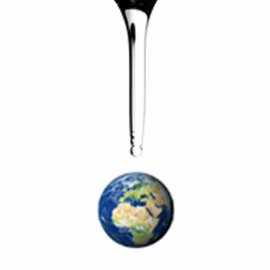Virtual Water
-
English
-
ListenPause
I’m Peter Neill, Director of the World Ocean Observatory. As we continue to work toward a fuller understanding of the presence of water in all aspects of our lives, we begin to look deeper into the hydraulic systems beyond the obvious – the ocean, the glaciers, the mountain ranges, streams, lakes, rivers, and wetlands – to the place where water lies hidden, unrecognized for its significance to our health, our diet, and our way of life. Of course, we know that we need – or at least the UN has established that we need – a minimum of 40 liters of fresh water per day to sustain our bodies to support physiological systems, hygiene, and the other mechanics of living successfully. We know our bodies are approximately 65% composed of water, evident in our blood, our organs, our muscles, our respiration, our digestion, and even our tears. The UNESCO Water Civilization Center asserts that an individual will consume some 25,000 liters of fresh water in an average lifetime to “keep the organic structures and biological functions in good working order.” We know these things, but we don’t always know their true value, until we become dehydrated and these systems begin to slow down and fail. What we may not know so well is what is called “virtual water,” the water that lies “behind” things, that is used to produce almost everything we incorporate into our daily routines but is not listed on the label or calculated into the price. The most obvious example is foodstuffs we consume, the amount of water that is used in production cycles to irrigate, wash, clean, and process the products on the supermarket shelves. UNESCO estimates that it takes, for example, 2,500 liters of fresh water to produce a hamburger, 1,000 liters for a liter of milk, 75 liters for a glass of beer, and 70 liters for that apple a day. A kilo of pork takes 4800 liters, of chicken 3700 liters, of citrus fruits 2000 liters. A kilo of coffee requires 21,000 liters, a single cup 150 liters, and that does not include the steamed milk should you so choose a latte. Virtual water calculation can be applied to so many other things we use. For example, a kilo of cotton requires 19,000 liters of water to produce, a fact that translates into 8,200 liters for a pair of jeans. Multiply that by all the cotton in all the clothes we wear and you have a virtual cascade. And then there’s energy required for the processing of the food and clothes and all the rest. According to The Energy Collective, all the increase in US energy production in 2010/11 can be allocated to the 27,000 shale gas wells drilled and hydraulically fracked, each requiring some 5 million gallons of water, amounting to some 135 billion gallons of water consumed and removed as result of contamination from the aquifer, the watershed, and availability for additional use. The number is astronomical, and that’s for just one year, in one nation, for one product in the energy mix. Then add the water required for plastic, packaging, chemical production, fertilizer, irrigation, manufacturing, and all the other processes in our consumption-driven economy and lifestyle, and the number becomes beyond comprehension until, as with our bodies we become dehydrated, deprived of sustaining water, and these systems begin to slow down and fail. There are so many examples and statistics you can drown in them. Here is one last: think of all the water lost when food is left on the plate, wasted, or processed foods extend beyond the use date and are discarded? We lose not just the water, but also the associated nutrition, the energy consumed to produce, the transportation cost of shipping from here to there, and the deficit subtracted from the global economy forever. We are at that point, now. We are a planet crying out for water, and we don’t seem to hear the call. We are 7 billion persons on earth, increasing every day, demanding water as a right, as the supply is poisoned, wasted, and withdrawn from the global value calculation. That’s not virtual; that’s real. We are what we drink, and without water, we are nothing. We will discuss these issues, and more, in future editions of World Ocean Radio.
In this episode of World Ocean Radio, host Peter Neill provides numerous examples of ways in which water consumption and use go unseen in our daily lives.
About World Ocean Radio:
Peter Neill, Director of the World Ocean Observatory and host of World Ocean Radio, provides coverage of a broad spectrum of ocean issues from science and education to advocacy and exemplary projects. World Ocean Radio, a project of the World Ocean Observatory, is a weekly series of five-minute audio essays available for syndicated use at no cost by college and community radio stations worldwide. A selection of episodes is now available in Portuguese, Spanish, French, and Swahili. In 2015 we will add Mandarin to our roster of global languages, enabling us to reach 75% of the world's population. For more information, visit WorldOceanObservatory.org/world-ocean-radio-global.
Resources from this Episode:
- Login to post comments



